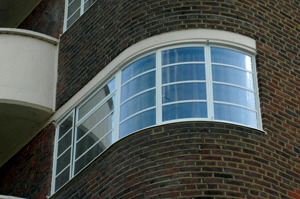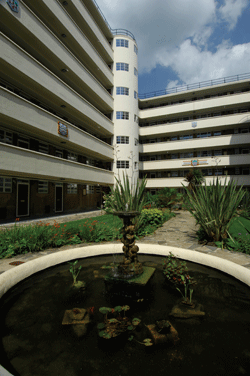
Restoration Program

|
| Click on Image to Enlarge |
In 2009, a restoration project was completed on time and on budget, replacing 70 year old windows. The images in this article show the finished windows.
In 2002 Festalfine Ltd. (Festalfine), the Lichfield Court management company, identified a need for replacing the existing steel windows within Lichfield Court. Residents were finding that some of their windows were no longer openable. There had also been many incidents where glass had simply fallen out and smashed on the private and public footways below. The existing windows formed part of the original construction and so had lasted nearly seventy years, but the need for replacement had now become inescapable. The condition survey carried out at this time confirmed this.
There was also an urgent and unavoidable need to replace the electrical infrastructure so it was decided that these two projects should be carried out concurrently.
In 2003 a further survey recommended that the existing windows should be replaced with aluminium windows. However, the application for permission to undertake this work, lodged with the local planning authority, was later withdrawn after the planners made it clear that aluminium would be unacceptable, in part due to the building being listed.
Extensive research
The listing of the building in 2004 led to the appointment of architects Hunter Price Chartered Architects to advise on window replacement. Discussions with the local authority conservation officer confirmed that aluminium was out of the question. Some leaseholders had previously replaced failing windows with PVCu alternatives but this material was also not permissible following the listing.
After extensive research involving a number of competitive steel window companies, it was decided that the window replacement work should be handled by Crittall Windows Ltd who, in addition to supplying and fitting 36 different window types, would also provide doors and privacy screens (which divided the balcony areas between each flat). In all some 1500 separate items would be needed.
Obtaining consent for the work to begin
Due to the 2004 listing of the buildings, Festalfine were faced with considerable conservation requirements to satisfy. In addition to this it was considered important to improve the thermal performance and acoustic protection of the current windows. As Lichfield Court lies directly beneath the flightpath of Heathrow airport, any relief that could be offered to the noise of the planes would be hugely beneficial.

|
| Click on Image to Enlarge |
The requirements of Festalfine, acting on behalf of all residents were clear from the outset:“It is of paramount importance that the type of window used should be one which, while preserving the character and appearance of Lichfield Court, will also bring benefits of improved safety, more efficient thermal and acoustic insulation and lower long-term maintenance costs, all at the most competitive price."
The content of this statement was of critical importance as the cost of the improvements would be borne by the leaseholders of the 211 flats, despite needing to satisfy third party requirements.
Before seeking final planning approval, Festalfine and Hunter Price fitted out a trial flat so the local authority conservation officer and representative from English Heritage could inspect the sample windows and seek any alterations required. It was important to ensure that those who would provide approval saw the finished product. This procedure allowed Festalfine to instruct Crittall on a number of alterations to satisfy conservation and practical requirements before proceeding to a full planning application. This resulted in changes to a number of fittings to both windows and doors.
English Heritage initially expressed concern at Crittalls’ intention to replace the original single glazed fenestration (placing of windows on the buildings exterior) with double-glazed units where a single pane of glass would ‘appear’ to be divided horizontally into smaller lights. This division would carried out by the addition of fixed steel intermediate glazing bars internally and application of intermediate glazing bars externally. The installation in Flat 81 proved invaluable in demonstrating how this would create an appearance that was virtually indistinguishable from the originals. As a result of the decision to produce windows for the ‘trial flat’, English Heritage withdrew its reservations about the use of double-glazed replacement windows in the project.
LVT

|
| Click on Image to Enlarge |
The Leasehold Valuation Tribunal (LVT), is an independent body appointed to make decisions in disputes arising in leasehold properties. The refurbishment project was subject to the LVT’s adjudication as a significant number of Lichfield Court leaseholders had referred the project, raising issues concerning the cost and validity of the proposals. In the event, the LVT found in favour of Festalfine’s plans as being the most efficient and cost-effective way forward but did require clarification on some costs. The latter was satisfied immediately, and Festalfine returned to the LVT to gain its full approval.
Festalfine lodged its final listed building and planning application for the refurbishment project with Richmond Council in June 2007. The applications (both window replacement and electrical) were recommended for approval by the Council’s conservation officer with support from English Heritage. The planning consent was granted in December 2007.
Article continues here
